Happy Wednesday! I recently read Chapter 4 of the book, What’s your Math Problem? and this was my favorite chapter so far. This chapter is all about the students using math problem solving strategies to get themselves organized before or while they are solving a problem.
The math problem solving strategies discussed in this chapter are:
- Look for a Pattern
- Create a Table
- Create an Organized List
- Guess and Check (My Favorite! This one rarely let me down in college math..hehe!)
It is important to note that these strategies do not have to be used in isolation. In fact, many students will use the strategies together or with another strategy. For example, a student may organize their guesses from Guess and Check into a table (Create a Table strategy).
Here is a break down of each strategy:
Look for a Pattern: This strategy starts in Kindergarten and has the students looking for numerical relationships through identifying, extending, or generalizing patterns.
Create a Table: This strategy will helps the student organize the information presented in the problem so that they can use another strategy to reach the solution.
Create an Organized List: this strategy is very similar to Create a Table in that it helps the students organize their information.
Guess and Check: This strategy, though often used by many students, could be developed into a more efficient problem solving strategy.
I loved how the book was all about modeling these strategies with the students. If modeled correctly and practiced enough in the younger grades, these students will be able to use these strategies fluently to solve more complex problems in grades 3-5.
The chapter provided different problems for each strategy to try out. The purpose was to have the reader reflect on how they were using the strategy and whether it was effective or not. Yikes! Math problems during the summer?! But, this inspired me to write similar word problems to use to model these strategies in the first weeks of school. Here they are with a chalkboard format. This format would be good for projecting them on a smartboard or promethean board because who has all that ink. 😀
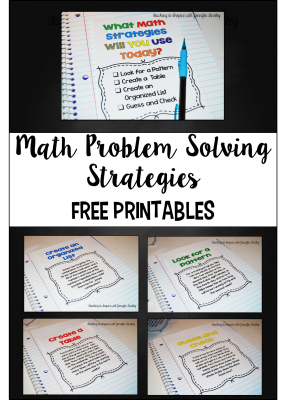





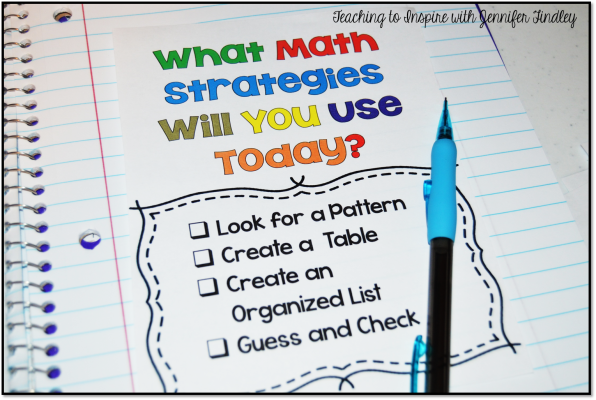
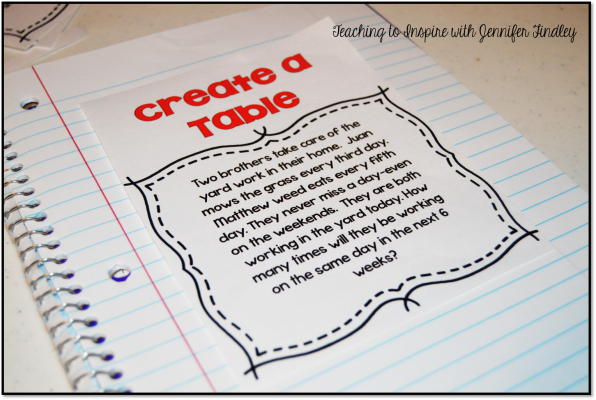
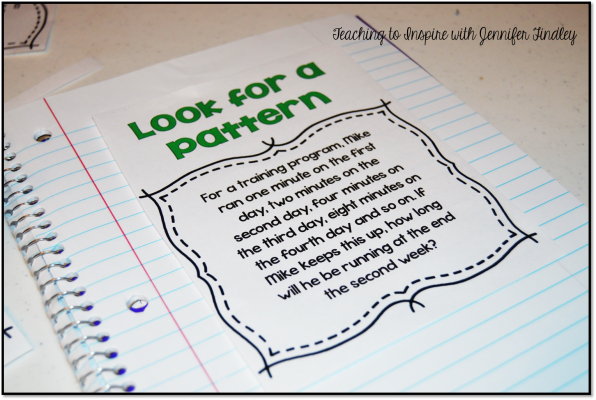
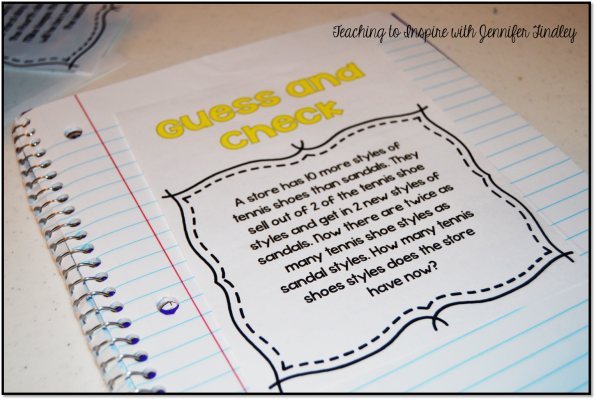
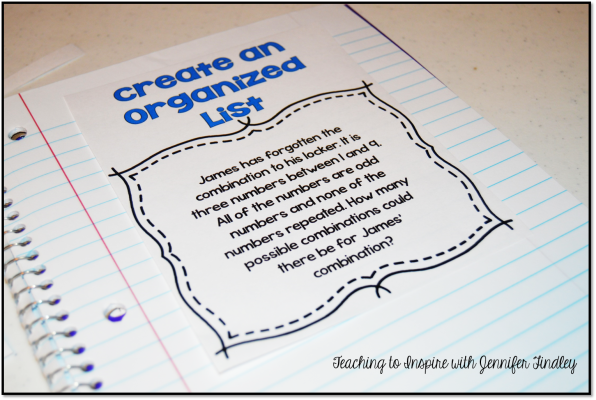







I just LOVE this! The patterning and guess and check strategies are excellent skills to have. I think having these up around the classroom to remind students they are perfectly find 'options' or ways to solve questions! So many students skip questions because they don't know how to solve it and I know I've taught guess and check methods which have really helped my year 9s! 🙂
Thanks for the very useful information Jennifer! 🙂
Liz – BaysideMathTeacher
I love guess and check! It has saved me many times on a math exam in college! Thanks for stopping by!
Jennifer
I spend some time on these strategies while launching math workshop–it would be so beneficial if they were introduced in the younger grades. I have to do a lot of front loading just to get them familiar with the terms and when to use them…appropriately. (The THINK framework helps with having students choose a strategy and why they chose it as a discussion first, then from the list of discussed strategies they can choose one that they want to use to solve the problem.)
I have to be more vigilant about this in the beginning of the year and spend more time on each strategy (the students had a lot of trouble answering the short and extended response questions)–I especially love Guess, Check, and Revise. I struggle with teaching students the difference between using a table and creating a list–at times, I feel like they are interchangeable.
Thank you for the posters–they are definitely going up in my room 🙂
–jen
Hi Jen!
I would love to hear more about this THINK framework you mention. And I LOVE how you call it Guess, Check, and Revise!
Glad you like the posters!
Jennifer
One strategy I found to work for my kids last year (especially since we were starting a new math series that was WAY different than what they were used to) was draw a model. I used the models you mentioned above as well, but a lot of my kiddos needed to draw it out or use manipulatives to finally understand what was happening in the problem. These posters are great…can't wait to use them!
Laura
Laura, I love using models! I am always telling my kids, "If you just draw a model, you will figure out the problem." We have an acronym in our room that we use that requires them to draw a model or other visual. We call it LOVE. Labels, Our Thinking, Visuals, Equations.
Thanks for stopping by!
Thank you so much for the math posters. These will become my 3rd grade anchor charts! I LOVED this chapter because it is where the rubber meets the road, so to speak. My favorite strategy is/and always has been guess and check. It is my "go to" strategy and has served me well. Having said that, I feel the four strategies present a more complete approach to problem solving and it is my goal to expose my students to these strategies and give them the opportunities to practice and learn each approach.
I believe the most difficult strategy for me is making a table. What to put where has always be a bit fuzzy to me. I want to work on this and be more confident as I use it in my classroom.
I agree with Jen's post…students need to be familiar with these strategies before they enter the middle grades. It is my goal for my 3rd graders to know these strategies, which is more appropriate when, and if they need to use more than one, as well as, to give them confidence as they grow mathematically.
Hi Pamela, I, too, am least comfortable with the Create a Table approach. And, yes can you imagine how great it would be if our kids knew these strategies before they came to us? It would make our lives so much easier!
Thanks for stopping by!
Jennifer
In teaching 6th grade for 3 years now, looking and analyzing tables has been difficult for me, too! I see now how looking for patterns and then creating the table work together. I was analyzing the create a table strategy in isolation from make a pattern strategy. As I read on, I am seeing the pattern and creating the table and loving it. I'm even preferring.
Great chapter…I am, and always have been, partial to the Guess and Check method. However, I've noticed when working with students that they are hesitant to use this method while problem solving. I never knew why until I read the following on p.100: "Sometimes we are uncomfortable with making an estimate or guess because we have been taught that in mathematics, we should follow a particular rule or algorithm."
Makes sense to me!
Great posters, Jennifer! Thank you for sharing!! 🙂
Mandy, thanks for sharing that quote from the book. It is interesting how much we shape the kids; minds to believe one thing or another about math, intentionally or not. I don't know about you, but I have really changed the way I view math instruction over the last couple of years! There is a wealth of research out there that is opening my eyes!
Thanks for stopping by!
Out of these four strategies, I think that Making an Organized List and Looking for a Pattern are my "go-to" strategies when solving math problems. I like a systematic approach as it is not only logical to me but also allows me to interpret misconceptions and be able to see where a mistake was made.
In my class I am supportive of all strategies as long as they can be proven to work in more than just an isolated case.
Love the posters and thing they would work great as a reminder for students!
Jennifer Smith-Sloane
4mulaFun
I love this chapter. Teaching how to organize in tables is not my strength. I love guess and check. I worked the problems and had to focus on the tables. I know that with the implementation of STAAR, these patterns have gotten much more complex. I have been working on a good way to teach this!
I love seeing my kids use strategies that they have and they share with others. My rule is it has to be mathematically sound (will it work to solve other similar problems). I saw some issues this year with students not answering what the question is asking so reading this book will make a huge difference in my math teaching this year.
Great summary of the chapter. Using tables is not one of my students' favorite tools, but I encourage them to try all methods and to become familiar with them. Not all problems can be solved with the same strategies so if they are having difficulties I suggest they try a different method.
Many times I think students want an immediate answer and give up if their favorite method doesn't work. I need to work on how to encourage them to continue and finish what they have started.
Thanks for sharing the posters.
Ana
Some students lack good testing strategies. My son struggled with this particularly in math. He experienced anxiety every time he took his exams. He attends a decent California public school but he just wasn’t doing so well. This school year, I decided to get him a math tutor in San Jose. The tutor really helped him improve his grades by getting him more organized and utilizing the strategies mentioned above.